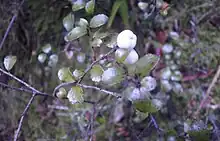| Gaultheria antipoda | |
|---|---|
 | |
| Scientific classification | |
| Kingdom: | Plantae |
| Clade: | Tracheophytes |
| Clade: | Angiosperms |
| Clade: | Eudicots |
| Clade: | Asterids |
| Order: | Ericales |
| Family: | Ericaceae |
| Genus: | Gaultheria |
| Species: | G. antipoda |
| Binomial name | |
| Gaultheria antipoda G.Forst.[1] | |
Gaultheria antipoda, commonly known as snowberry or fools beech, is a shrub in the family Ericaceae. It is endemic to New Zealand.[1]
Description
G. antipoda is an upright or spreading shrub that grows to 1–2 metres (3.3–6.6 ft) high. The leaves are 5–15 mm (0.20–0.59 in) long, and are leathery, shiny, with small serrations. G. antipoda flowers around November, followed by white to red berries in late summer and autumn.[2] Unlike some other Gaultheria species that exhibit gynodioecy, G. antipoda is a hermaphroditic species (the individuals produce both pollen and seeds). [3]
Distribution
This species is found in the North Island between 37° - 39°30'S in lowland to subalpine scrub habitat particularly on cliffs and rocky places.[4]
References
Wikimedia Commons has media related to Gaultheria antipoda.
- 1 2 "Gaultheria antipoda G.Forst". New Zealand Organisms Register. Retrieved 2019-05-15.
- ↑ "Snowberry (Gaultheria antipoda)". Taranaki Educational Resource: Research, Analysis and Information Network. Retrieved 25 May 2012.
- ↑ Delph, Lynda F.; Lively, Curtis M.; Webb, C. J. (2006). "Gynodioecy in native New Zealand Gaultheria (Ericaceae)". New Zealand Journal of Botany. 44 (4): 415–420. doi:10.1080/0028825X.2006.9513032. ISSN 0028-825X.
- ↑ Eagle, Audrey (2008). Eagle's complete trees and shrubs of New Zealand volume two. Wellington: Te Papa Press. p. 536. ISBN 9780909010089.
This article is issued from Wikipedia. The text is licensed under Creative Commons - Attribution - Sharealike. Additional terms may apply for the media files.